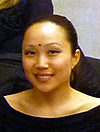Updated: December 31, 2012

Lila Gollogly Glotfelty
CBC Scholar: Class of 2011
PhD Candidate, Department of Microbiology and Immunology, UIC; Advisor: Gail Hecht
HECHT LAB WEBPAGE
On August 17, 2012, Lila successfully defended her thesis: "Enteropathogenic E. coli EspG1/G2 Perturb Microtubules and Impede Tight Junction Regulation and Recovery." Congratulations!
Currently, Lila is back in the medical school (MD/PhD Program) and will likely graduate in 2014.
RESEARCH INTERESTS:
My thesis research investigates the contribution of microtubules to epithelial tight junction function and recovery. Our lab studies Enteropathogenic E. coli, bacteria that injects effector proteins into the host cell. Two of these effector proteins, EspG1/2, destroy microtubule networks. I had completed proof-of-principle studies earlier in my PhD and this past year I focused on the bacterial protein itself. I cloned the bacterial protein into a mammalian vector and tagged it with Red Fluorescent Protein (RFP). I then expressed this protein in mammalian intestinal epithelial cells and stained the microtubules to determine the effect of this one protein on them. It turns out that EspG1 can destroy microtubules by itself, without any help from other effectors or chaperone proteins. I have also made progress in determining the effect of microtubule destruction on tight junction structure, using a biotinylation recycling assay. This is a novel assay that uses surface-labeling of tight junction proteins to track them as they move in and out of the cell. I am looking forward to pursing this further in the upcoming year.
This year I also spent considerable time in the lab of Dr. Jerrold Turner (UChicago) learning a permeability assay from one of his graduate students. In this assay, a living mouse is anesthetized and the leakiness of its intestines is measured. This is a challenging and time-consuming assay performed by only a few labs in the world. I was very lucky to have had the opportunity to be instructed there first-hand. We have also been working with one of his recent graduate students on a different permeability assay involving the collection of a fluorescent tag to measure intestinal leak.
Additionally, our lab’s recent focus on microtubules has led us to pursue a collaboration with Dr. Vladimir Gelfand at Northwestern. I recently met with him to discuss some possible projects we could perform in his lab including real-time imaging of fluorescent microtubules in the presence of EspG1. We are excited to start this new collaborative effort.
PUBLICATIONS:
Glotfelty LG, Hecht GA. Enteropathogenic E. coli effectors EspG1/G2 disrupt tight junctions: new roles and mechanisms. Ann N Y Acad Sci. 2012 Jul;1258(1):149-58. (PubMed)
AWARDS / VOLUNTEER EXPERIENCE:
- Judge, Chicago Public Schools Student Science Fair, March 2012
- CBC Scholar 2011-2012
- Student representative on the UIC College of Medicine Admissions Committee
- Co-chair of the UIC Interview Sub-committee (responsible for managing/reforming the interview
process) - Student representative on the M4 curriculum reform committee (responsible for radically
changing/improving the M4 curriculum)
